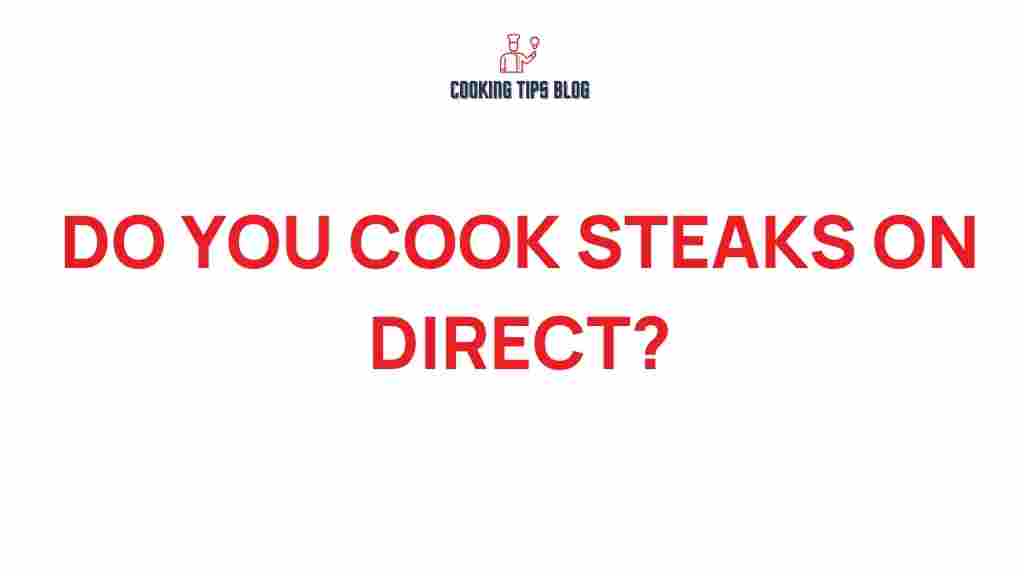Cooking Steaks: Do You Cook Steaks on Direct Heat?
When it comes to cooking steaks, the method you choose can significantly impact the flavor and texture of your meat. One prevalent question among home cooks and grill enthusiasts is whether to cook steaks on direct heat. In this ultimate guide, we’ll explore the topic in detail, diving into the advantages and disadvantages of direct heat cooking, as well as offering tips and techniques for achieving the perfect steak every time.
The Basics of Cooking Steaks
Steak is a beloved protein around the world, celebrated for its rich flavor and tender texture. Understanding the fundamentals of cooking steaks will help you make informed choices about how to prepare them. Whether you prefer a juicy ribeye, a tender filet mignon, or a flavorful sirloin, mastering the cooking techniques is essential.
What is Direct Heat Cooking?
Direct heat cooking refers to the method of exposing food directly to the heat source. This approach is commonly used for grilling, broiling, and pan-searing. When cooking steaks on direct heat, the meat develops a delicious sear, which locks in juices and enhances flavor.
Advantages of Cooking Steaks on Direct Heat
- Quick Cooking Time: Direct heat cooking is fast, allowing you to achieve a beautifully seared steak in just a few minutes.
- Flavor Development: The high heat caramelizes the surface of the steak, creating a rich, savory crust.
- Temperature Control: It’s easier to monitor the steak’s doneness when using direct heat, helping you avoid overcooking.
Disadvantages of Cooking Steaks on Direct Heat
- Risk of Overcooking: Steaks can easily go from perfectly cooked to overdone when exposed to high temperatures.
- Flare-Ups: Cooking on direct heat can cause fat to drip onto the flames, leading to flare-ups that may burn the meat.
- Limited Cooking Techniques: Direct heat may not be suitable for thicker cuts of meat that require longer cooking times.
How to Cook Steaks on Direct Heat: A Step-by-Step Guide
Now that we understand the pros and cons of direct heat cooking, let’s dive into the process. Follow these steps to achieve the perfect steak every time:
Step 1: Choose the Right Cut of Steak
Select a steak cut that is suitable for direct heat cooking. Popular options include:
- Ribeye
- New York Strip
- Filet Mignon
- Sirloin
Step 2: Prepare the Steak
Before cooking, it’s essential to prepare your steak properly:
- Bring to Room Temperature: Allow the steak to sit at room temperature for about 30-60 minutes before cooking. This ensures even cooking.
- Season Generously: Use salt, pepper, and any other spices or marinades you prefer. Don’t be shy with the seasoning!
Step 3: Preheat Your Grill or Pan
If you’re using a grill, preheat it to high heat. For pan-searing, heat a heavy skillet (preferably cast iron) over medium-high heat. Make sure the cooking surface is hot enough to sear the steak upon contact.
Step 4: Cook the Steak
Place the steak on the grill or skillet:
- For Grill: Cook the steak for 4-5 minutes on one side without moving it. This allows for a good sear.
- For Pan: Add a little oil to the skillet, then place the steak in. Cook for 3-4 minutes on each side for medium-rare.
Step 5: Check for Doneness
Use a meat thermometer to ensure your steak reaches the desired doneness:
- Rare: 120-125°F
- Medium Rare: 130-135°F
- Medium: 140-145°F
- Medium Well: 150-155°F
- Well Done: 160°F and above
Step 6: Rest the Steak
After cooking, let the steak rest for at least 5-10 minutes. This allows the juices to redistribute, resulting in a more flavorful and tender steak.
Troubleshooting Tips for Cooking Steaks on Direct Heat
Even seasoned cooks can encounter challenges when cooking steaks. Here are some troubleshooting tips:
Steak is Overcooked
If your steak turns out overcooked, consider the following:
- Use a meat thermometer to monitor temperature accurately.
- Reduce cooking time for thinner cuts of steak.
Steak Lacks Flavor
If your steak is bland, ensure you’re seasoning it adequately. Consider marinating the steak for a few hours before cooking to enhance flavor.
Steak is Tough
Tough steak can result from cooking at too high a temperature or not allowing it to rest. Always let the steak rest after cooking to ensure tenderness.
Conclusion
Cooking steaks on direct heat can yield delicious results when done correctly. By following the steps outlined in this guide, you’ll be well on your way to mastering the art of cooking steaks. Whether you prefer grilling or pan-searing, understanding the fundamentals and troubleshooting common issues will elevate your steak-cooking game.
For more cooking tips and techniques, check out our other articles on cooking techniques. With the right knowledge and practice, you’ll be able to impress your friends and family with perfectly cooked steaks every time!
If you’re looking for more resources on grilling techniques, visit The Grilling Authority for comprehensive guides and recipes.
This article is in the category Tools and created by Cookingtipsblog Team
